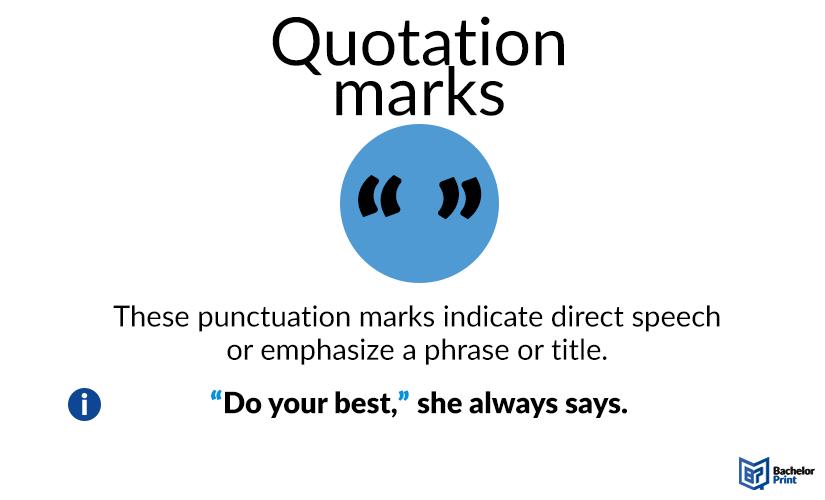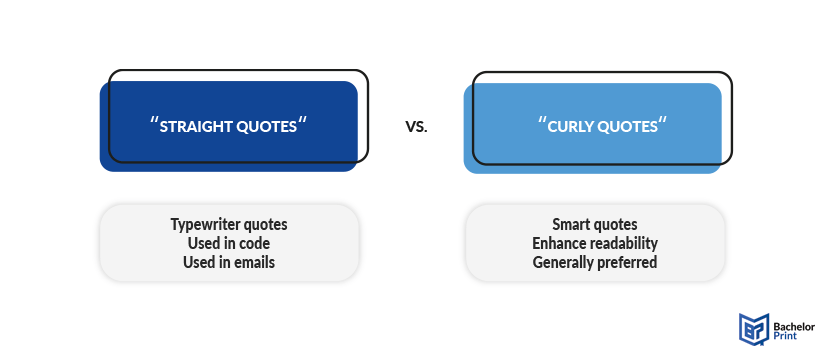
As a part of language rules, one of the primary uses of quotation marks is to indicate direct speech or to highlight words or phrases taken verbatim from another source. Furthermore, punctuation marks can signify titles of short works, indicate irony, or introduce unfamiliar terms. This strengthens the depth and precision of your writing. This article will delve into the types of quotation marks, how to properly use them, and how they work in combination with other punctuation.
Definition: Quotation marks
These punctuation marks are mostly used to represent direct speech and can either be single or double. The use of single and double quote marks will differ depending on the version of English you are using (American or British). Punctuation marks introducing the quote are always placed outside the quotation marks, but sentence-ending punctuation marks may or may not be placed within the quote marks. They can also imply alternative meaning or represent the titles of books or other works.

Functions
Quotation marks come in several forms and serve various functions. So, it’s important to use quotations correctly in writing in order to make things clear and precise.
Quotation marks are used to indicate when someone is speaking.
They denote text taken directly from another source.
Quotation marks are used to enclose titles of short works like articles, poems, songs, and chapters.
They are used to convey irony or sarcasm in a word or phrase.
Quotations are often used to introduce terms or phrases that might be unfamiliar to the reader.
The widespread usage of quotation marks poses an integral role in an array of languages, where they take on different shapes and formatting. For instance, low-high quotation marks („…“) are standard in German usage and other languages.
Types
There are various types of quotation marks, each serving a specific purpose in academic writing. The widely known types in the English language are single quotation marks, double quotation marks, curly quotation marks, straight quotation marks, and single and double angular quotation marks. In British English vs. American English, the first two punctuation marks are used differently. Each type is delved into in the following with respective examples.
Single quotes
Single quotation marks (‘…’), or single quotes, consist of opening and closing quotation marks. Unlike the standard double marks, they represent the shape of apostrophes. These marks can be in the form of curly quotes, also referred to as smart quotes, curved quotes, and typographical marks, or straight quotes, also called typewriter marks.
Single quotes pose an important punctuation tool used primarily in British English, but they also have specific uses in American English.
In British English, single quotes are used to enclose speech, quotation within quotations, titles of works, or to indicate irony or unfamiliar vocabulary.
In American English, single quotes are primarily punctuation marks for nesting quotes, and occasionally, in ironic context or unfamiliar words or phrases.
Double quotes
The double quotation marks (“…”), also called double quotes, are a crucial punctuation tool in the English language. However, there are slight differences in applying them in British English vs. American English.
In British English, they are primarily used for quotes within quotes, whereas in American English, they are standard punctuation marks for direct speech, nested quotations, titles of certain works, and irony or unfamiliar terms. Basically, the other way around.
Straight quotes vs. curly quotes
Quotation marks come in two main styles: curly quotation marks, also referred to as smart quotes or typographical marks, and straight quotation marks, also referred to as typewriter marks.
Curly quotes are curved quotation marks that are the preferred style in most printed and formal digital texts due to their aesthetic and readability advantages. They are designed to visually indicate the opening and closing of a quotation.
Appearance
Curly quotation marks are distinct in their appearance, representing curved quotation mark characters. Both single quotes and double quotes have a clear opening and closing quotation mark.
Usage
Curly quotation marks are used in formal writing, typeset text, and publications, as curly quotes visually enhance readability and provide a professional aesthetic. Therefore, many word processors automatically convert straight quotation marks to curly quotation marks as you type.
Straight quotation marks, also known as typewriter or vertical quotation marks, are simple vertical lines that, in contrast to curly quotation marks, do not differentiate between opening and closing quotation marks. They are commonly used in informal digital texts and programming due to their simplicity.
Appearance
Straight quotation marks are identical vertical quotation marks for both the opening and closing mark.
Usage
Straight quotation marks are used in plain informal text, coding, and when curly quotes are not supported or necessary. They are usually the default quotations marks in most text editors and programming environments.

Double angle quotes
Single and double angled quotation marks, also known as guillemets, are used in a range of languages and have distinct appearances and rules compared to the standard quotes. Single guillemets are, however, not commonly used anymore in the French language.
Double angle quotation marks («…») are prominently used in French, Russian, and several other languages to indicate direct speech and quotations. They are also used in some styles of formal writing and literature as English quotes, though less common.
Appearance
This type of angled quotation marks consists of double left-pointing and double right-pointing angular quotes, resembling small double arrows pointing outwards.
Usage
In French usage, it is applied in direct speech and quotations, having the same function as the English-style standard quotation marks. They are typically used with non-breaking spaces inside the quotation marks in French typography.
Rules
When using these punctuation marks, you will need to take note of the following rules.

Capitalizations
If you are quoting a complete sentence, the first word after the quotation has to be capitalized. You will not need to capitalize the sentence if you are only quoting a part of a phrase. When you split the quoted text, you will not need to capitalize the second part of the sentence. Here are some examples:
You should take note of the use of commas. After the initial quote, you will use the comma within the quotation mark. In the second part of the quotation, the comma has to be outside the quotation mark. However, the full stop or full stop will be placed within the quotation mark.

Exclamation & question marks with quotes
When using question marks and exclamation points, you only need to place them in the quotation marks if they are part of the quote. When it comes to colons, semicolons, and dashes, the same rules apply.

Commas with quotes
Punctuation marks that introduce quotes are never placed within the quotation marks, but there are different rules for punctuation marks that end the quotes. In American English, commas and periods are always placed within the quotation marks. However, in the UK, commas and periods or full stops are only placed in the quotation marks if the quote is a full sentence or if the punctuation marks are part of the quotation.
- ✓ 3D live preview of your individual configuration
- ✓ Free express delivery for every single purchase
- ✓ Top-notch bindings with customised embossing

Examples
Below, you’ll find numerous example sentences on how to use quotations.
FAQs
Quotation marks are used to enclose direct speech, quotes, or titles of certain works. They can also indicate a word or phrase being discussed or used ironically.
- Double Quotation Marks (“ ”) – Commonly used in American English for direct speech or quotes.
- Single Quotation Marks (‘ ’) – Often used in British English or for quotes within quotes.
- Guillemets (« » or ‹ ›) – Used in French and some other languages.
Three examples are listed below:
- Direct speech: She said, “I’m going to the shop.”
- Quote within a quote: ‘He shouted, “Leave me alone!”’
- Titles: I just read “To Kill a Mockingbird.”
You can use double quotation marks for the main quote and single quotation marks for the quote within the quote. Or, vice versa when using British English. Generally, we’d recommend using indirect quotes instead.
- American English: “She said, ‘I’m happy.’”
- British English: ‘She said, “I’m happy.”’
When using American English, periods and commas go inside the quotation marks.
Examples
- “I’m ready.”
- American people write it “this way.”
When using British English, periods and commas go outside the quotation marks unless part of the quote.
Examples
- ‘I’m ready.’
- British people write it ‘this way’.
